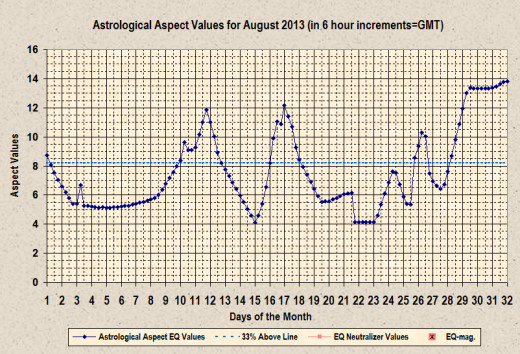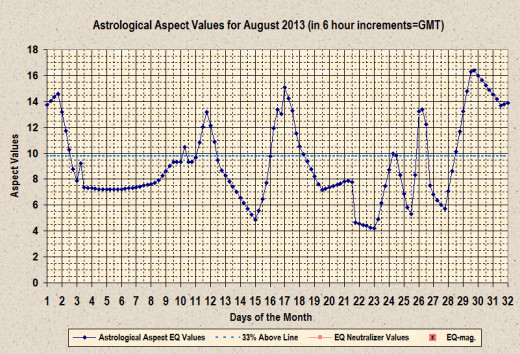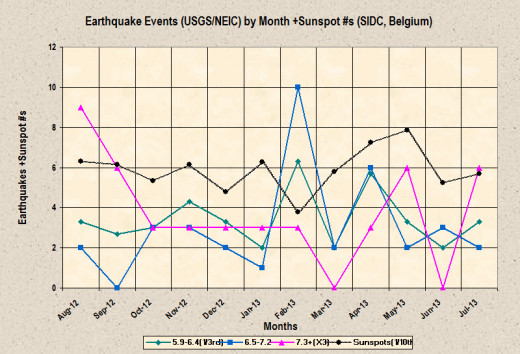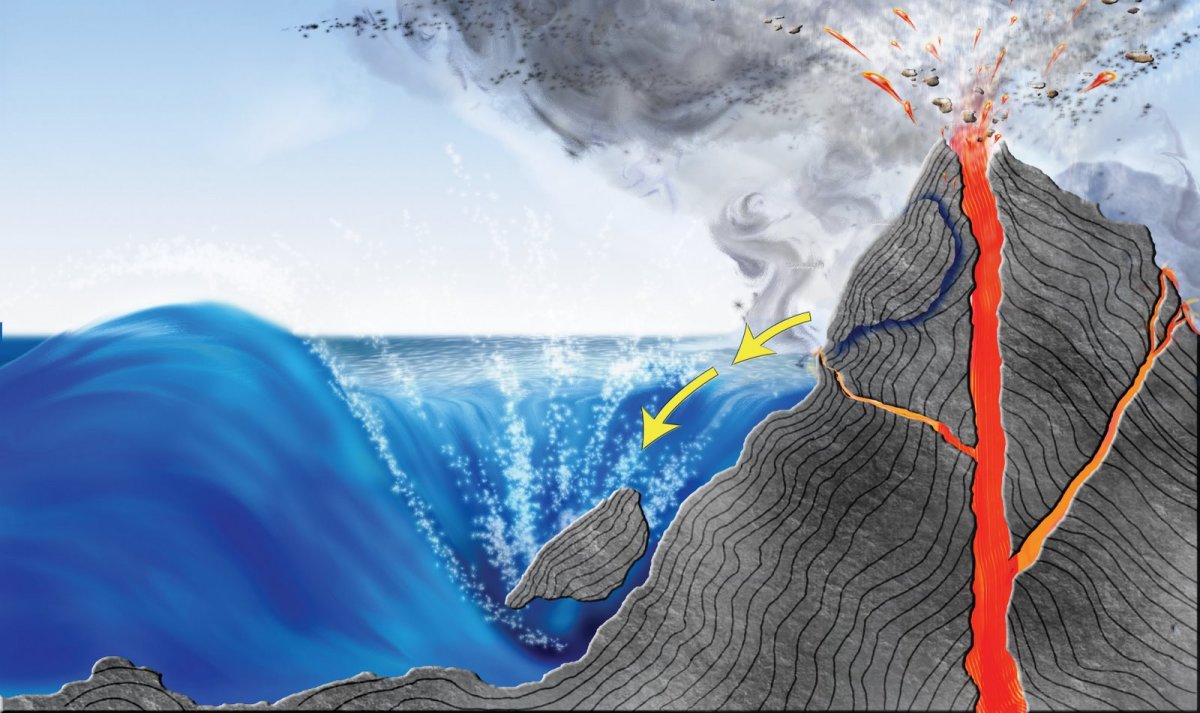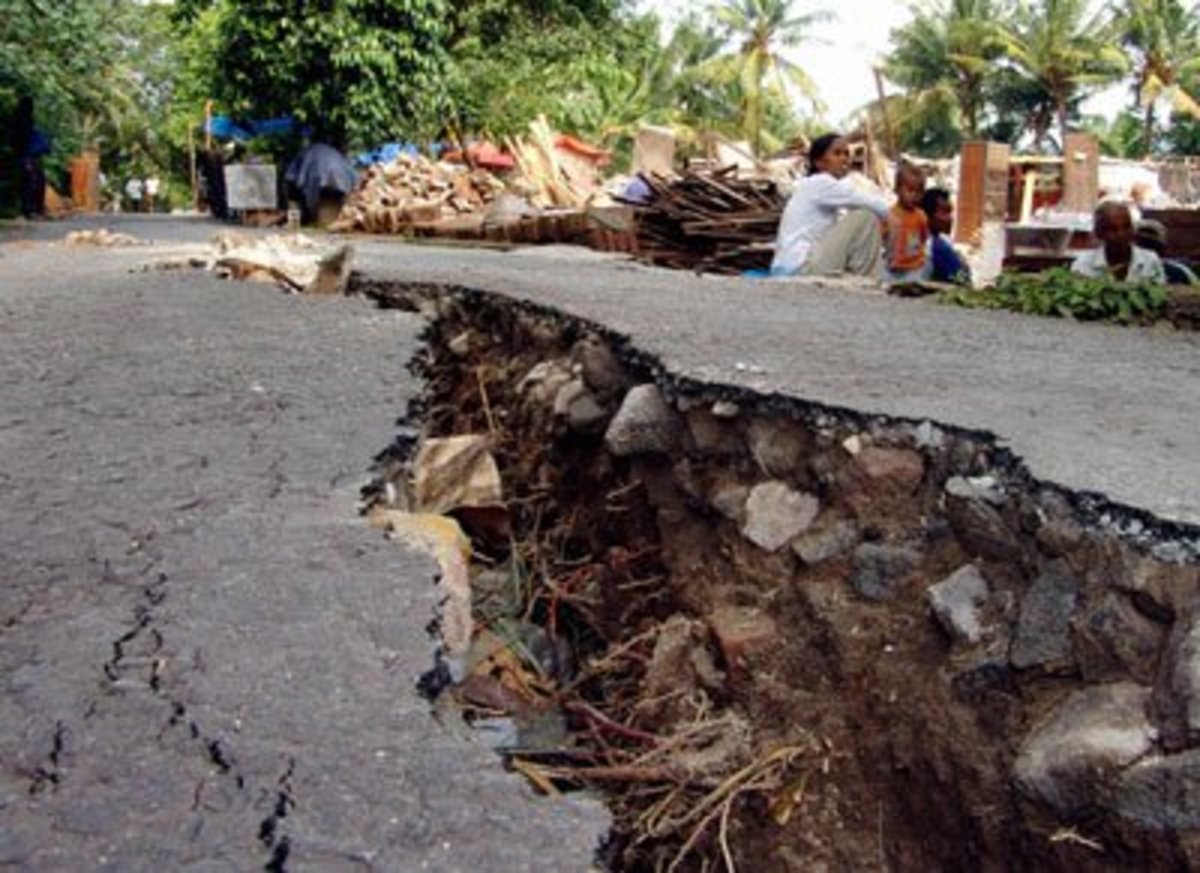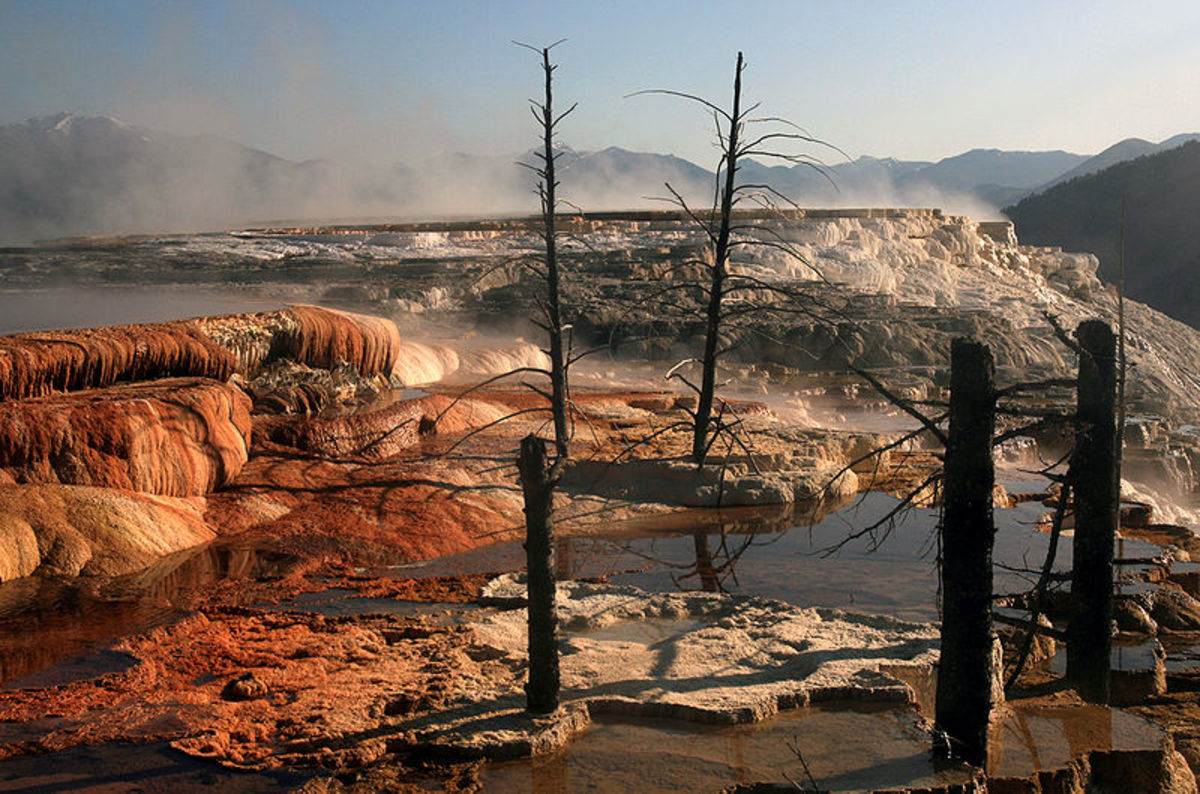Astrology Linked to Largest Earthquakes plus August Forecast
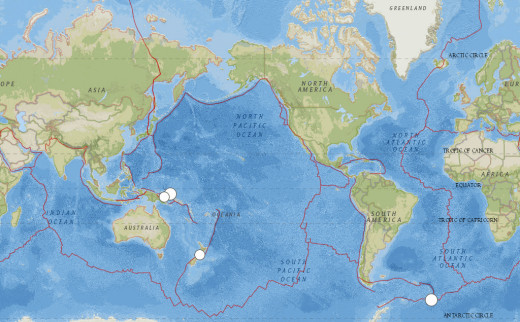
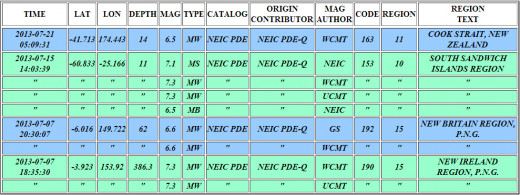
In a recent hub, the occurrence of earthquakes was compared to astrologically derived window areas for the year ending in mid July 2013. When looking at earthquakes of 7.3 magnitude or larger, it was found that they occurred twice as frequently inside the windows than outside of them, even though the days comprising the windows were half as many as for the days outside of them. This remains true even when extending the period of study back a few more months to the beginning of 2012.
There was also significant results for earthquakes in the 6.5 to 7.2 magnitude range; with quakes within the windows occurring 1.7 times more often than the statistical average. However, if one removed the 6 aftershocks within that magnitude range that occurred following the 8.0 magnitude Solomon Islands earthquake in February 2013 and the 1 aftershock following the 8.3 magnitude Sea of Okhotsk earthquake in May 2013, then the significance was reduced to 1.4 times that of the statistical average.

While earthquakes of lesser magnitude resulted in reduced significant results, those of greater magnitude produced even more significance. In other words, if one looked at just the earthquakes of 7.8 magnitude or larger, all 3 of them occurred within the window zones and 0 occurred outside of those windows. This remained a consistent feature even if one looked back a few months further. In the first 5-1/2 months of 2012 there were 2 such large quakes occurring within windows and 0 outside of them.
If we focus on earthquakes between these lower and higher ranges or those of 7.25-7.74 magnitude, the occurrence of earthquakes inside the window areas was 1.75 times that of what would normally be expected (if astrology was found not to be a factor).
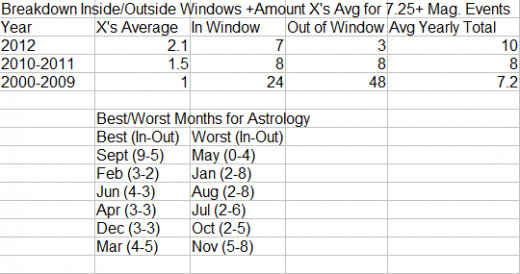
Because of the above results I have decided to raise the bar that determines what a significant earthquake event is. From this point on, I will be concentrating on magnitude 7.3 or greater events in my forecasts. I may still display 6.5 to 7.2 magnitude events in maps when reviewing a prior month of activity, but the primary focus will be of events above that range, if there are any (usually 4 to 6 months of a year have no 7.25 magnitude or greater events).
Besides looking at the past year, a study was initiated to review earthquake activity from the years 2000-2012. Looking at events of 7.75 magnitude or higher, 2012 did best of any year with 3 quakes inside the windows and 0 quakes outside of them. For the years before that, the quakes inside the windows occurred 1.5 times more often than the statistical average.
Similar to this last result was that for 7.25 to 7.74 magnitude events where the most significant results also occurred in 2012 (or 1.71 times more than average within the window areas). The next best results were for the years 2010 and 2011 when, as was the case for the largest quakes, their were 1.5 times more earthquakes inside the windows than would have been expected statistically or in a random sample. The results were consistent for both 7.25 to 7.74 magnitude quakes and 7.75 magnitude or higher ones.
However, for 7.25-7.74 magnitude earthquakes for the years 2000 through 2009, the results were below average. Earthquake occurrences were distributed more like a random display. What this seems to indicate is that, at least for the years 2000 through 2009, astrology was not a factor on earthquake activity for quakes below 7.75 in magnitude.
Things appeared to shift gear in 2010 through 2011 when astrology seemed to play a noticeable part for earthquakes just below the 7.75 magnitude threshold (7.25-7.74) and then, in April 2012, a turning point occurred when the bar was lowered dramatically as to what earthquakes could be significant (including earthquakes down to 6.5 magnitude) in relation to astrological factors. Not only did the range of earthquake strengths broaden, but the proportion of events inside the windows to outside the windows increased significantly and there were less months without 7.25 magnitude or higher events. It is apparent to me that this change is still in force, but it is unclear as to whether this effect will be sustained for a long or short term.
One factor that is likely related to this recent expansion of what earthquakes will be reflected by astrological aspects is that earthquake activity, at least for the largest earthquakes, has been on the increase.
If one looks at the 20 years from 1992 through 2011, one finds that 7.1 magnitude events occur on average once each month. For 7.3 magnitude or greater events (during this same period) they happen about 2 times every 3 months (based on an average of 0.63 earthquakes per month). If one looks at the 3.5 years ending in mid July 2013 however, one sees that they occurred more like once each month (the actual average is 0.89 earthquakes per month). But an acceleration of the increase is happening even as I write this. Looking at seismic activity from the start of the year 2012 to the middle of July 2013 it yields 18 such quakes out of 18.54 months or 0.97 earthquakes per month on average (even though 7 out of 18.54 months or 37.76% had no such quakes fall within them). Looking at just the start of 2013 to the middle of July 2013, there were 7 events of 7.25 magnitude or higher. If this 6.54 month period is divided into these 7 events, one gets a monthly average of 1.07 earthquakes. The trend continues to be up (even July 2013 is well above its most recent average monthly value in seismic activity).

To get a better picture, I conducted a breakdown of earthquakes for different time periods and found that for 7.75 magnitude or greater events, the yearly average was 1.41 for the years from 1900 through 1999 and it was twice as much or 2.82 per year for the more recent period beginning at the start of 2010 and ending in mid July 2013. It would be a bit higher or 3.25 per year if one looks at the most recent period that includes all of 2012 and ends in mid July 2013.
Similarly, there has been a significant increase in earthquakes in the 7.25 to 7.74 magnitude range. For the years 1900 through 2009 the yearly average comes out to 4.44 while for 2010 through mid July 2013, it is 7.9 per year. If one looks at just the recent year from 7/16/2012 to 7/15/2013, the yearly value is 12. If we include earthquakes of 7.75 magnitude and higher it comes out to an annual rate of 15 for this most recent time frame which is alarmingly high when compared to the 6.07 yearly average for this range of quakes (7.25+) during 1900-2009. I should point out here however that the earthquake record is pretty much complete for the years from 1900 to 1964 for 7.75 magnitude or greater events but not nearly as much so during that same period for 7.25 magnitude to 7.74 magnitude events.
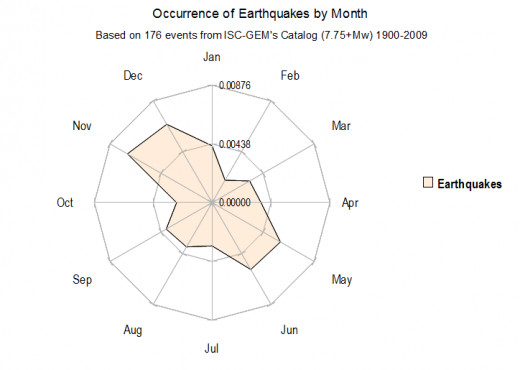
Recently I extracted 176 earthquakes of 7.75 magnitude or larger (for 1900-2009) from the ISC-GEM catalog and used them to determine the frequency of events by month. From this I found that November and December had the highest frequency of earthquakes (1.64 times that of average for the former and 1.57 times for the later) or nearly tied for 1st place. Similarly the two opposing months of May and June (1.34 times average for the former and 1.31 times for the later) were nearly tied for 2nd place. August, the month we will be looking at shortly, was not much less than average (only January came extremely close to the average value). July, which would normally see just one quake of 7.3 magnitude or greater (based on the most current data from the USGS website) was well above average in 2013 (as mentioned earlier). Not only that, but astrology was clearly still appearing to play a role since both significant earthquakes (of 7.3 magnitude) happened inside window areas (as currently calculated).
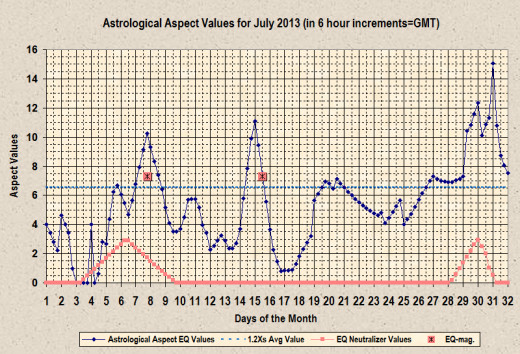
As a result of my findings, I here present a general overview of how significant earthquake activity should unfold for August:
For 7.25 magnitude or greater events:
August: Chance for no event occurring: 46%
Chance of one event occurring: 38%
Chance of 2, 3, or 4 events occurring: 16%
The above is based on a breakdown of seismic events solely in the month of August for the years 2000 through 2012. The chances should be smaller for no event happening and larger for one or more events happening since different rules seem to have applied starting in April 2012. For the years 2000 through 2011, there were 8 earthquakes outside window areas and none inside. It was not until August 2012 when things turned around and two events occurred within window areas and one outside. With the frequency of larger seismic events still on the increase I would not be surprised if August 2013 has a modestly strong showing with something like one event within a window and none outside or perhaps a 50-50 split with one earthquake inside one of the windows (totaling roughly 10 days in duration) and one outside the window area(s)(of around 20 days in length).
This brings up another change in how I will be measuring quakes in relation to astrological aspects. Besides moving the bar up to 7.3 magnitude or greater for defining a significant seismic event, I will have the bar set for the astrological aspect values at 1.2 times their average for the month being studied and then adjust that line up or down if needed to have the values for 33% of the month above the line and the values for 67% of the month below the line (for August 2013 it went down from 9.3 to 8.2).
And finally, after a longer than usual hub, it is time for the astrological forecast that indicates window periods and possible locations for potential earthquakes in the month of August 2013. Most listed locations will end with one or more U.S. states (two letter codes used for). These locations are included even though any quake in those areas would likely be well under the 7.3 magnitude minimum that locations outside of the U.S. need to qualify for consideration. The exceptions where a 7.3 magnitude event may still be possible in the U.S. are Alaska first followed by possibly California or Hawaii. Although there has been much talk about potential mega quakes in the New Madrid area of the central U.S. and off the coast of Oregon and Washington, I feel there is, at the present time, greater potential for devastating earthquakes in California than in either of those two locations. I often hear that we are overdue for a massive quake in the Pacific Northwest and in the central U.S., but in fact we may be due but not overdue. We are overdue on the Hayward fault in the San Francisco bay area and on the San Andreas fault near Los Angeles (or a fault that branches off of it). Now for the forecast:
8/1/2013: midpoint: 0600 UTC (give or take 6 hours; peaks in late July, 2013): Peru, Ecuador, Japan, China, Mexico, Turkey, HI.
8/11/2013, peak at 1800 UTC (begins at 2100 UTC on 8/9 and ends at 2100 UTC on 8/12): Turkey, China, Japan, Greece, Russia, KY/TN.
8/17/2013, peak at 0000 UTC (begins at 0000 UTC on 8/16 and ends at 0000 UTC on 8/18): Japan, Turkey, CA.
8/26/2013, peak at 0600 UTC (begins at 1700 UTC on 8/25 and ends at 1600 UTC on 8/26): Mexico, China, Turkey, CA.
8/30/2013, midpoint at 0130 UTC on 8/30 (large area with no pronounced peak, beginning at 1000 UTC on 8/28 and extending beyond the end of the month): China, Mexico, Iran, Turkey. Earthquakes should be more likely after the midpoint than before.
Copyright © 2013 Joseph W. Ritrovato
